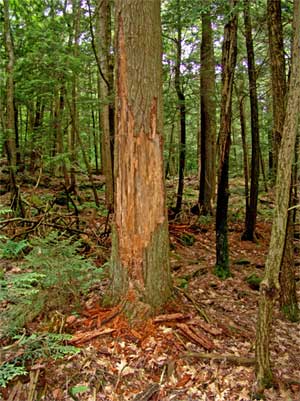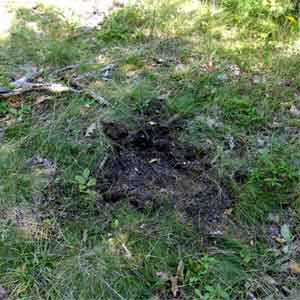The Catskill Mountains have approximately 1,500 to 2,000 black bears. Black bears can be found on almost all of the mountain ranges in the Catskill Mountains. The Catskill Mountains have the highest density population of Black Bears in New York State. The north side of the Kaaterskill Mountain Range (around 1800-3,300') has the highest density population in the Catskill Mountains.
Male black bears average around 300 pounds, where female black bears average around 160 pounds. Male black bears can reach up to 750 pounds. 99% of black bears in the Catskill Mountains are black in color. The 1% can be either albino or brown. Black Bears on the west coast of the United States have a much higher population of brown colored black bears. There are NO grizzly bears, brown bears, or polar bears in New York.
Black bears are omnivorous and eat berries, fruit, acorns, nuts, seeds, insects, grubs, and carrion, grass, corn, honey, bird seed, trash, and pet food when available. In the spring, they can sometimes take fawns, fish, birds, and other small animals. They will also feed on dead animals. They really like ants. You can often see them digging the earth looking for insects and ants.
While black bears appear awkward and slow, but don't be fooled. They can sprint up to 40 mph in short burst, and can accelerate quite rapidly. You cannot out run them. They are excellent at climbing trees and swimming. They do have poor eye sight, but have highly sensitive smelling ability.
When a bear stands on it's hind legs, it is smelling you. This is not a sign of aggression. If you encounter a bear, they will often run for a short distance, and then stop and stand on their hind legs. When they stand on their hind legs they are smelling you. This is normal.
Most black bears prefer wild forest with mixed conifers and deciduous trees. They prefer areas where humans do not venture into often. They have a roaming range up to 150 miles. Females usually have a smaller range of 7-30 square miles. Males have a range of 60 square miles. They often follow established animals trails. When human hiking paths exist, they will take those. Black bears are active from dawn to dusk. But, in heavy human population areas, they will often roam at night. They can be found in most counties in New York.
Black bears usually go into hibernation around January 1. Female black bears give birth during January. They will sometimes leave the den when they are in labor. They can be very dangerous to approach when they are in labor. You are most likely to be attacked during this time. They will stay in their den until around April 1 depending upon the weather. Most black bears in the Catskill Mountains will use natural stone caves to hibernate. But, they will dig dens with caves are not available.
How do I know if bears are nearby?:
Clawed trees.
Black Bear Scat. Larger the pile, the larger the bear.
Ground digging spots.
Black Bears mark their territory by clawing trees. You will usually see claw marks on trees from 4-7 feet off the ground. Sometimes the claw marks are hard to see, while other times, the bear will maul the tree pretty good. The more bear scat you see, the more likely you are to see a bear. Bear scat is most often very black in color, and sometimes a nice pile. Coyotes have scat that looks a lot like a dog. Black bears spend a lot of time turning over rocks and digging in the ground to find ants and insects. The more dig spots, the more likely you are to encounter a bear. Fresh scat and diggings is often a sign that you are fairly close to a bear. Two pictures on the right show diggings. One is a small hole, while the second picture shows a large dig. Freshly dig soil means a bear close by. Black bears can lift rocks 3 times their own weight. So, a 600 pound male bear can lift a 1,800 pound rock.
How do I avoid conflicts with black bears?:
Make noise, so that they can hear you coming.
Look up often to see if you can see any bears.
Avoid areas that have ripe blueberries.
Make noise and be more cautious when the wind is blowing in your face.
Use caution when hiking in heavy brush areas.
Avoid bears walking around in January
Use extra caution when the wind is blowing in your face
Avoid surprising a bear to avoid an attack out of fear.
Most black bears will move out of the way if they hear someone approaching them. If you are hiking alone, and you think a bear is nearby, just clap your hands loudly, or yell, "Hey Bear!". Most bears hear or smell you coming. Bears have an incredible sense of smell. Most people watch the ground when they are hiking so that they don't trip over a rock. Look up from time-to-time to make sure that you don't trip over a bear. Avoid areas that have a ripe food source. Expect to find bears near blueberry patches when they become ripe. If acorns have recently fallen off an oak tree, bears will be there to eat them. If the wind is blowing at your back, your smell will travel a great distance to warn bears that you are coming. Bears can smell you from one mile away. But, if the wind is blowing in your face, they will not smell you until you are very close. Bears like to nap in thick brush, so if you are bushwacking be careful. Also think before you enter an area with high bushes near food sources. Black bears hibernate, but also give birth in January. Some mothers are in pain, and will walk outside their den in January. They are very agitated, and are most likely to attack a person just before giving birth. Once they give birth, they become very docile again. When the wind is blowing at your back, bears can smell you from a mile away. But, when the wind is blowing in your face, you can walk into a bear without the bear knowing it. Startling a bear is always bad. Some will attack you when startled.
What to do if you encounter a bear:
Never EVER run from a bear. Back away slowly.
Turn sideways at a 45 degree angle.
Do NOT stare at a bear.
Do NOT use a large lens camera to photograph them. Small pocket cameras are okay.
Do NOT feed them.
Do NOT climb a tree
Do NOT corner them
Do NOT try to pet their cubs
Do NOT get between a mother and her cubs.
Grunts and snapping of the jaw is your first warning that you are too close
If the bear faces you directly, this is your second warning that you are too close
If the bear starts jumping up-and-down on their front legs this is your last warning before they attack you
Some bears may do a bluff charge, where others will attack when they charge you
If you encounter a bear, there are some things you should and shouldn't do. Never EVER run from a bear. Running from a bear will instinctively make them chase you, and attack you. Do not stare at the bear. Bears interpret staring as achallengee and a form of aggression. Staring at them willencouragee them to attack you. Bears consider large photograph lens as big wide eyes, which is a super form of aggression. This may be why photographers have the highest incidence of bearattackss. If you encounter a bears, turn slightly sideways, and look down. Then start backing away slowly. Females and young bears will often move off away from you before you even see them. Females can be more aggressive them males when believe that you intend to harm their cubs. Never ever move towards her cubs, or do anything that threatens them. Males on the other hand, often will not move out of the way, and expect you to move out of the way. Give them space.
What to do if you attacked by a bear:
Use Bear Spray if you have some.
If knocked down or attacked get on your stomach, and play dead.
Cover your neck and head with your hands
If a bear comes into your tent at night, fight back
A 100 pound bear can kill a 200 pound person
In the United States Black bears kill one person approximately every two years. The danger of being killed by a black bear is very small. They are usually very docile and tolerant of people.
|
 |
 |
 |
American Black Bear |
 |
 |
 |
Black Bear Scatching |
 |
 |
 |
Large Bear Scat |
 |
 |
 |
Bear Diggings |
 |
 |
 |
Bear Diggings |
|

